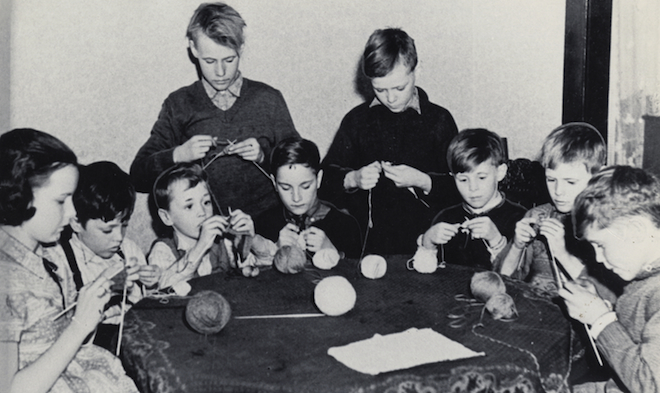Canada’s war museum ponders peace
Michael Petrou on the artifacts and stories within the museum’s latest exhibition
Children help knit socks and other garments for Canadian service personnel. Voluntary organizations like the Canadian Red Cross and the Navy League of Canada distributed them overseas. (George Metcalf Archival Collection / Canadian War Museum)
Share

It is at once an incongruous and entirely appropriate theme for an exhibition at the Canadian War Museum: Peace.
Seeking peace has long been cited as a reason for war. Prime Minister Robert Borden invoked it when taking Canada into the slaughter of the First World War. More than 90 years later, a newly elected Prime Minister Stephen Harper visited Canadian soldiers in Afghanistan and described their work there as helping Afghanistan become a peaceful country.
About a third of the exhibition, which runs until January, deals with avowed peace-seeking military interventions, such as the First World War and Afghanistan. But here too the exhibition is unusual. The Afghanistan section features medals awarded to Bushra Saeed-Khan, a young Canadian diplomat who was grievously injured and lost a leg during a 2008 attack on a Canadian convoy that killed four soldiers and a journalist. The section also includes a “Troops Out” placard from an anti-war demonstration.
“The fact that it’s speaking to directly to the difference of opinions on Afghanistan shows the enlightenment of the museum,” says Renée Filiatraut, a former diplomat in Afghanistan whose civilian dog tags are displayed. “The forum for that debate has been very rare.”
For the first time since the new War Museum opened in 2005, there is a sizable display on the Spanish Civil War and the involvement of almost 1,700 Canadians in it. In this war, too, a desire for peace pushed men to fight and die. Spanish General Francisco Franco had launched a rebellion against a democratically elected Spanish government in 1936. He had the backing of Nazi German and Fascist Italy. Canadians who fought on behalf of the Spanish government believed that if fascism could be stopped in Spain, a larger European war might be avoided.
“If I, an enraged pacifist, am a soldier today, it’s because I hate war,” Canadian Robert Martineau wrote to a friend from Spain in 1938. “And to destroy war, we must destroy the regime that is responsible for it.”
The Spanish Civil War section includes a display on the only surviving Canadian combat veteran of the war, 96-year-old Jules Paivio, who was awarded Spanish citizenship two years ago. “Tears came to my eyes thinking about my dad,” says his son, Martin, who drove to Ottawa from Aurora to see the exhibition. “He wanted to come.”
The exhibition covers events from the origins of the aboriginal Six Nations Confederacy, to Canada’s 2010 mission to Haiti. Presenting such a diverse array of topics in a coherent manner is a challenge. But the exhibition holds together — in part because of its inherent contrasts. The Canadian protest movement against the war in Vietnam is juxtaposed with a display about the more than 30,000 Canadians who fought there. There are also artifacts telling the story of the many American draft dodgers who fled to Canada during the Vietnam War.
Frank Scarfino is one of them. He came to Canada three decades years ago and has lived here since. His draft card is on display, along with his Canadian landed immigrant status paper from 1971.
“For me, it’s an intensely personal experience. I cried for days before coming up here,” he says of visiting the exhibition. “It’s something I believed in with all my heart. I still do.”
Some artifacts are notable because of their historical significance. Lester Pearson’s Nobel Peace Prize is on loan from Canada’s Department of Foreign Affairs. There is the signature page from an 1842 treaty that settled a dispute regarding the border between Maine and New Brunswick.
More evocative, though, is material history that is deeply personal. During the Second World War, conscientious objectors in Canada, including Mennonites and Doukhobors, were allowed to perform peaceful national service work such as logging and farming, rather than combat-related tasks.
One man who did so was Mennonite Elmon Lichti, who helped build the northern Ontario highway between North Bay and Nipigon. He died in 2005. The following spring, while helping to clean out his house, his children came across an old pair of leather work boots. Lichti had worn them during the war and kept them ever since.
“They apparently had great emotional staying power for my dad,” says Lichti’s son, Jim.
“They symbolize service to country in an atypical way. They show that through service and love there are other avenues to peace.”